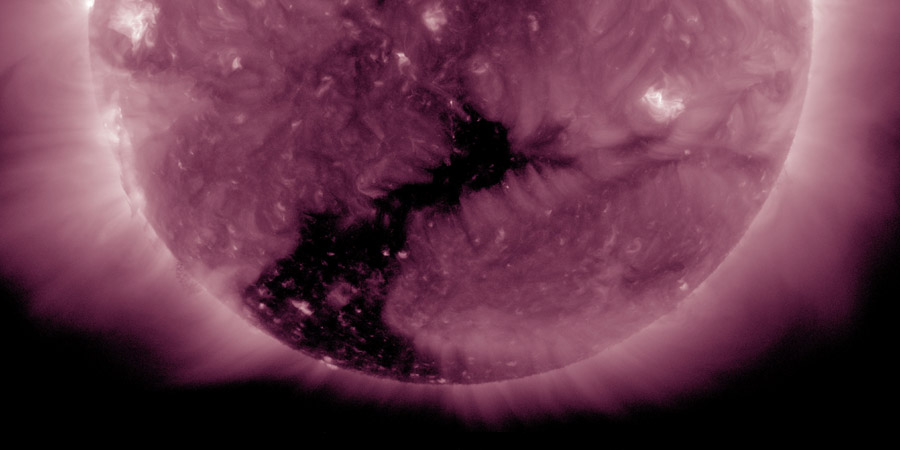Coronal hole, CME impact expected, FAQ
Sunday, 14 February 2016 14:44 UTC

A northern extension of the southern hemisphere polar coronal hole is now facing Earth.
While it doesn't have an equatorial portion, we should still experience some noticeable effects when the solar wind stream arrives at Earth in about three days from now. Kp-values of 4 might be possible on Wednesday, which stands for active geomagnetic conditions.
Coronal mass ejection impact expected
A coronal mass ejection is expected to arrive at our planet early tomorrow. More information about that can be found here. The NOAA SWPC has a minor G1 geomagnetic storm watch in effect for later tonight and early tomorrow due to this incoming plasma cloud. A quick look at the ACE EPAM monitor does make us worry a tiny bit. The low energy protons are still way down and that is not a good sign. This plot should show elevated values as the plasma cloud approaches our planet. Could this mean we will see a weak impact or perhaps even a complete miss? Let's hope not but it's not looking all to great at the moment. Still, this coronal mass ejection could be much slower than antipated and perhaps arrive later as well. That could also explain the rather disappointing EPAM values we are seeing right now. Like always, it's going to be a waiting game so be sure to keep an eye on the data on our website.

Image: ACE EPAM plot on 14 February at 15:31 UTC.
Frequently Asked Questions (FAQ)
Today we are also introducing a new page here on SpaceWeatherLive! A Frequently Asked Questions (FAQ) page! One of the most important missions we have here on SpaceWeatherLive is that our visitors learn about space weather when they visit our website. That is exactly the reason why we have a large help section with many articles where we dig deeper in the world of space weather. However, we still receive a lot of questions here on SpaceWeatherLive and some of these questions return every so often. The questions we receive the most often can now be found on a special page. If there are any questions that we did not answer there then you are of course welcome to post them on our community forum.
Thank you for reading this article! Did you have any trouble with the technical terms used in this article? Our help section is the place to be where you can find in-depth articles, a FAQ and a list with common abbreviations. Still puzzled? Just post on our forum where we will help you the best we can!
Latest news
Latest forum messages
Support SpaceWeatherLive.com!
A lot of people come to SpaceWeatherLive to follow the Sun's activity or if there is aurora to be seen, but with more traffic comes higher server costs. Consider a donation if you enjoy SpaceWeatherLive so we can keep the website online!

Space weather facts
| Last X-flare | 2025/03/28 | X1.1 |
| Last M-flare | 2025/04/01 | M5.6 |
| Last geomagnetic storm | 2025/03/27 | Kp5 (G1) |
| Spotless days | |
|---|---|
| Last spotless day | 2022/06/08 |
| Monthly mean Sunspot Number | |
|---|---|
| February 2025 | 154.6 +17.6 |
| Last 30 days | 128.5 -22.7 |


